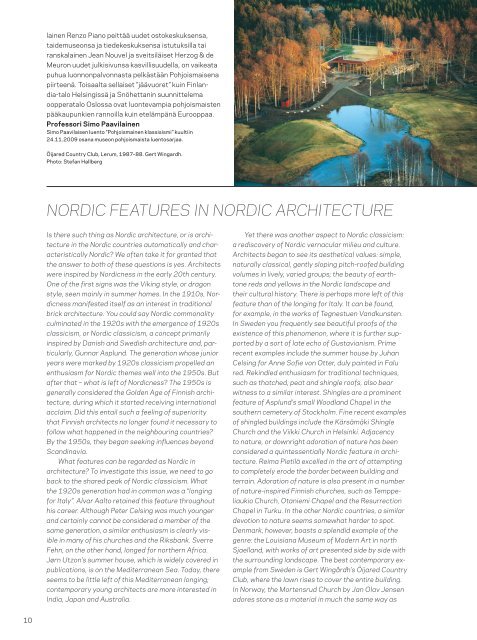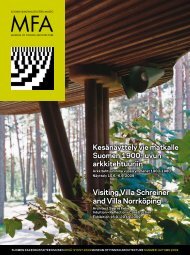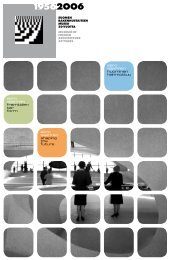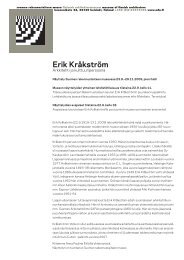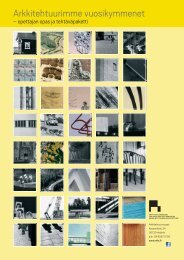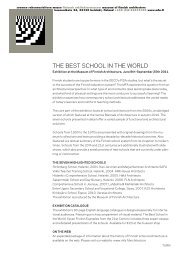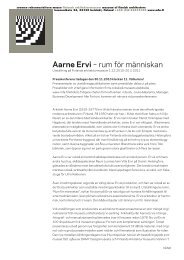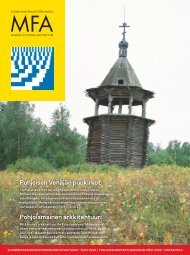Finnish Architecture 0809 - Suomen rakennustaiteen museo
Finnish Architecture 0809 - Suomen rakennustaiteen museo
Finnish Architecture 0809 - Suomen rakennustaiteen museo
You also want an ePaper? Increase the reach of your titles
YUMPU automatically turns print PDFs into web optimized ePapers that Google loves.
lainen Renzo Piano peittää uudet ostokeskuksensa,<br />
taide<strong>museo</strong>nsa ja tiedekeskuksensa istutuksilla tai<br />
ranskalainen Jean Nouvel ja sveitsiläiset Herzog & de<br />
Meuron uudet julkisivunsa kasvillisuudella, on vaikeata<br />
puhua luonnonpalvonnasta pelkästään Pohjoismaisena<br />
piirteenä. Toisaalta sellaiset ”jäävuoret” kuin Finlandia-talo<br />
Helsingissä ja Snöhettanin suunnittelema<br />
oopperatalo Oslossa ovat luontevampia pohjoismaisten<br />
pääkaupunkien rannoilla kuin etelämpänä Eurooppaa.<br />
Professori Simo Paavilainen<br />
Simo Paavilaisen luento ”Pohjoismainen klassisismi” kuultiin<br />
24.11.2009 osana <strong>museo</strong>n pohjoismaista luentosarjaa.<br />
Öijared Country Club, Lerum, 1987–88. Gert Wingardh.<br />
Photo: Stefan Hallberg<br />
Nordic features in Nordic architecture<br />
Is there such thing as Nordic architecture, or is architecture<br />
in the Nordic countries automatically and characteristically<br />
Nordic? We often take it for granted that<br />
the answer to both of these questions is yes. Architects<br />
were inspired by Nordicness in the early 20th century.<br />
One of the first signs was the Viking style, or dragon<br />
style, seen mainly in summer homes. In the 1910s, Nordicness<br />
manifested itself as an interest in traditional<br />
brick architecture. You could say Nordic commonality<br />
culminated in the 1920s with the emergence of 1920s<br />
classicism, or Nordic classicism, a concept primarily<br />
inspired by Danish and Swedish architecture and, particularly,<br />
Gunnar Asplund. The generation whose junior<br />
years were marked by 1920s classicism propelled an<br />
enthusiasm for Nordic themes well into the 1950s. But<br />
after that – what is left of Nordicness? The 1950s is<br />
generally considered the Golden Age of <strong>Finnish</strong> architecture,<br />
during which it started receiving international<br />
acclaim. Did this entail such a feeling of superiority<br />
that <strong>Finnish</strong> architects no longer found it necessary to<br />
follow what happened in the neighbouring countries?<br />
By the 1950s, they began seeking influences beyond<br />
Scandinavia.<br />
What features can be regarded as Nordic in<br />
architecture? To investigate this issue, we need to go<br />
back to the shared peak of Nordic classicism. What<br />
the 1920s generation had in common was a “longing<br />
for Italy”. Alvar Aalto retained this feature throughout<br />
his career. Although Peter Celsing was much younger<br />
and certainly cannot be considered a member of the<br />
same generation, a similar enthusiasm is clearly visible<br />
in many of his churches and the Riksbank. Sverre<br />
Fehn, on the other hand, longed for northern Africa.<br />
Jørn Utzon’s summer house, which is widely covered in<br />
publications, is on the Mediterranean Sea. Today, there<br />
seems to be little left of this Mediterranean longing;<br />
contemporary young architects are more interested in<br />
India, Japan and Australia.<br />
Yet there was another aspect to Nordic classicism:<br />
a rediscovery of Nordic vernacular milieu and culture.<br />
Architects began to see its aesthetical values: simple,<br />
naturally classical, gently sloping pitch-roofed building<br />
volumes in lively, varied groups; the beauty of earthtone<br />
reds and yellows in the Nordic landscape and<br />
their cultural history. There is perhaps more left of this<br />
feature than of the longing for Italy. It can be found,<br />
for example, in the works of Tegnestuen Vandkunsten.<br />
In Sweden you frequently see beautiful proofs of the<br />
existence of this phenomenon, where it is further supported<br />
by a sort of late echo of Gustavianism. Prime<br />
recent examples include the summer house by Juhan<br />
Celsing for Anne Sofie von Otter, duly painted in Falu<br />
red. Rekindled enthusiasm for traditional techniques,<br />
such as thatched, peat and shingle roofs, also bear<br />
witness to a similar interest. Shingles are a prominent<br />
feature of Asplund’s small Woodland Chapel in the<br />
southern cemetery of Stockholm. Fine recent examples<br />
of shingled buildings include the Kärsämäki Shingle<br />
Church and the Viikki Church in Helsinki. Adjacency<br />
to nature, or downright adoration of nature has been<br />
considered a quintessentially Nordic feature in architecture.<br />
Reima Pietilä excelled in the art of attempting<br />
to completely erode the border between building and<br />
terrain. Adoration of nature is also present in a number<br />
of nature-inspired <strong>Finnish</strong> churches, such as Temppeliaukio<br />
Church, Otaniemi Chapel and the Resurrection<br />
Chapel in Turku. In the other Nordic countries, a similar<br />
devotion to nature seems somewhat harder to spot.<br />
Denmark, however, boasts a splendid example of the<br />
genre: the Louisiana Museum of Modern Art in north<br />
Sjaelland, with works of art presented side by side with<br />
the surrounding landscape. The best contemporary example<br />
from Sweden is Gert Wingårdh’s Öijared Country<br />
Club, where the lawn rises to cover the entire building.<br />
In Norway, the Mortensrud Church by Jan Olav Jensen<br />
adores stone as a material in much the same way as<br />
10


